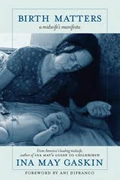
Title: Birth Matters: a midwife’s manifesta
Author: Ina May Gaskin
Source: Veddma library
ISBN: 978-1-58322-927-9
Available online
Notes: As always, Ina May does not disappoint. This book brings forth a deep discussion of the importance of birth in lives of children being born, mothers giving birth, and families. It talks about demonization the midwifery profession has received with the rise of male-driven obstetrics and an unbending medical system with monetary goals at its forefront. It calls all of us to grasp the scale of maternal and infant mortality, and help lower it by instituting standardized reporting on causes and circumstances of birth-related deaths.
Ina May calls to feminists not interested in motherhood, who have distanced themselves from maternal health issues, to consider that the right of a woman to have a safe birth is as important as the right to choose whether to have children. “We need to deepen our understanding of where we have been as women in the past and how the past has shaped and often distorted our knowledge of our bodies and ourselves, especially in the realm of pregnancy and birth.” “The way a culture treats women in birth is a good indicator of how well women and their contributions to society are valued and honored.”
The book is full of research findings and statistics on birth matters: C-section rates (90-95% in Brazil, for instance, contrasted by about 30% in US, versus 10-15% maximum recommended by the World Health Organization, and 2-3% as reported by some communities with births assisted by midwives); maternal mortality (US has worse maternal death rates than Cuba, Bulgaria, Hungary); history of introduction of certain “labour-assisting” drugs and medical procedures which have proven to cause numerous complications, but are still being taught in medical schools and applied in the field; – this book is a wealth of information.
There are fewer birth stories in this book than in the “Spiritual Midwifery” or the “Ina May’s Guide to Childbirth“, since the emphasis of this book is on research. However, there are numerous examples illustrating the ability of the female body to labour and birth without interventions. Ina May does touch on the importance of birth stories: without them women do not know what a normal birth is, and are often subjected to unnecessary interventions that are likely to lead to unneeded surgery and birth trauma. The media portrayals of birth as almost always an emergency that requires being rushed to a hospital and attended upon by a team of doctors, who apply all imaginable instruments and techniques (forcepts, vacuum, scalpels, monitors, epidurals, episiotomies, drugs) to save the woman’s life and extract the baby, lead to families being scared of birth, believing that women are unable to birth unassisted, and they end up undergoing similar experiences. Birth stories show us the reality of childbirth, the variety of experiences, and make us realize that birth cannot be put on a conveyer (approach that is so pervasive in a hospital setting), bound to a clock, and forced to progress despite the woman’s body, instead of harnessing its abilities to birth without intervention.
Ina May also touches on the principles of the natural birth movement, including normalcy of birth, empowerment and autonomy of the woman, and avoiding unneeded routine procedures. She also covers the principles of humanized birth, in which health professionals work together in harmony to assist the woman in birth while leaving her in control of all decisions.
For those who care about health of the women and babies in their lives, and who wish to dig deeper into the history and research surrounding birth, hospital practices, unneeded interventions, the importance of the midwifery profession, and preservation of the birth-related knowledge, this book will answer many questions and provide references to more resources. I also highly recommend Ina May’s film “Birth Story” about The Farm midwives, which further discusses the development of medicalized birth and the impacts it has on birth outcomes, while showing how one community took birth into their own hands and produced way better outcomes than those of US hospitals.





